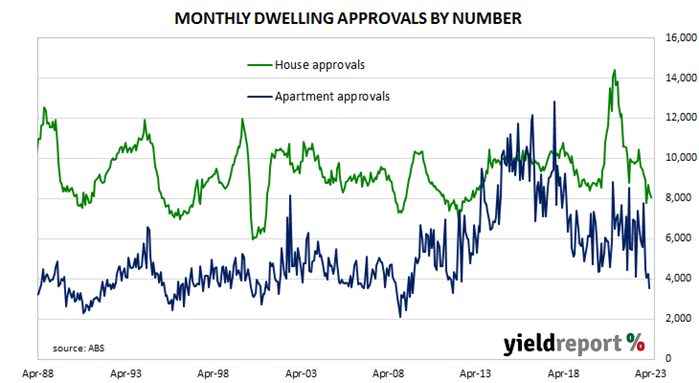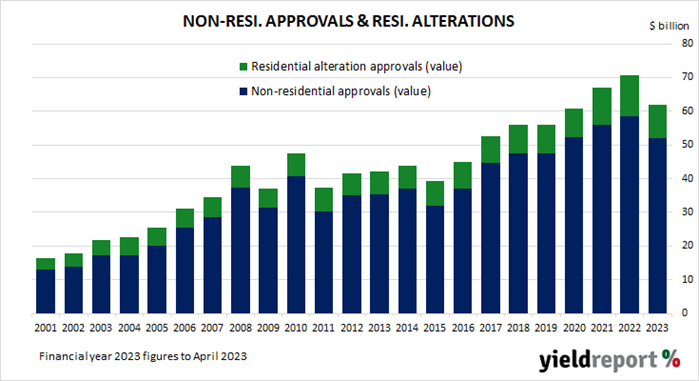Summary: Home approval numbers down 8.1% in April, contrasts with expectations; 24.1% lower than April 2022; Westpac: significant broad-based down-trend remains firmly intact; Westpac: very large backlog of work only thing preventing big falls in new construction; house approvals down 3.6%, apartments down 16.9%; non-residential approvals up 13.5% in dollar terms, residential alterations down 1.2%.
Building approvals for dwellings, that is apartments and houses, headed south after mid-2018. As an indicator of investor confidence, falling approvals had presented a worrying signal, not just for the building sector but for the overall economy. However, approval figures from late-2019 and the early months of 2020 painted a picture of a recovery taking place, even as late as April of that year. Subsequent months’ figures then trended sharply upwards before falling back in 2021 and 2022.
The Australian Bureau of Statistics has released the latest figures from April which show total residential approvals fell by 8.1% on a seasonally-adjusted basis. The fall contrasted with the 2.0% increase which had been generally expected and it was a greater one than March’s 1.0% fall after revisions. Total approvals fell by 24.1% on an annual basis, down from the previous month’s figure of -17.6%. Monthly growth rates are often volatile.
“While housing construction was not expected to follow the firming evident across the wider market, new home sales had suggested activity was starting to find a bottom in recent months,” said Westpac senior economist Matthew Hassan. “Instead, the April update points to a significant broad-based down-trend that remains firmly intact.”
Commonwealth Government bond yields generally declined modestly on the day following falls in US Treasury yields overnight. By the close of business, the 3-year ACGB yield had returned to its starting point at 3.43%, the 10-year yield had lost 2bps to 3.69%, while the 20-year yield finished 1bp lower at 4.07%.
In the cash futures market, expectations regarding rate cuts in 2024 softened. At the end of the day, contracts implied the cash rate would remain essentially steady at the current rate of 3.82% to average 3.87% in June but then rise to 3.95% in July. February 2024 contracts implied a 3.945% average cash rate while May 2024 contracts implied 3.82%, in line with than the current rate.
Approvals for new houses fell by 3.6% over the month, a slightly smaller fall than March’s -3.7%. On a 12-month basis, house approvals were 18.2% lower than they were in April 2022, down from March’s comparable figure of -15.1%.
Apartment approval figures are usually a lot more volatile and April’s total dropped by 16.9% after an 4.9% fall in March. The 12-month growth rate fell from March’s revised rate of -22.0% to -34.9%.
“The only thing preventing this weakening in approval playing through to big falls in new dwelling construction this year is a very large backlog of work,” Hassan added. “[A]s at December there were still around 240,000 dwellings under construction, a near record high reflecting the multitude of disruptions and delays to activity through 2022.”
Non-residential approvals rose by 13.5% in dollar terms over the month and were 29.8% higher on an annual basis. Figures in this segment also tend to be rather volatile.
Residential alteration approvals declined by 1.2% in dollar terms over the month and were 2.7% lower than in April 2022.



